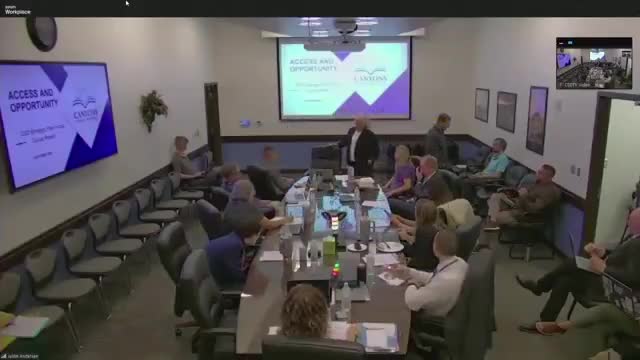Canyons strategic‑plan focus group outlines timetable to address access, multilingual and at‑risk student needs
October 08, 2025 | Events, Canyons School District, Utah School Boards, Utah
This article was created by AI summarizing key points discussed. AI makes mistakes, so for full details and context, please refer to the video of the full meeting. Please report any errors so we can fix them. Report an error »

Paula Logan, director of federal and state programs, briefed the board Oct. 7 on work by the district’s strategic‑plan focus group for Access and Opportunity, describing the data the committee will study and a schedule for focused monthly discussions.
Logan said the focus group divided its work into three stakeholder groups — students, parents and teachers — and identified four student populations of particular interest: multilingual learners, students with disabilities, low‑income/underserved students and gifted/advanced learners. "We've got students, we've got parents, we've got teachers that we're trying to make sure all have that access and that opportunity to work on that department," Logan said.
The committee reported district counts and disparities to illustrate where supports are concentrated. Logan said multilingual learners totaled nearly 5,000 students representing roughly 79 languages districtwide and that multilingual learners make up about 12.6% of the district, with several elementary and secondary schools exceeding 20% and two schools above 40% in particular grades. She said the district’s special education population was about 12.9% and that the committee noted increases in both resource and self‑contained placements. Logan also summarized McKinney‑Vento (students experiencing unstable housing) counts and housing types recorded by the district; she said about 0.8% were unsheltered, about 3% were in hotels or motels and most (about 83–84%) were doubled‑up.
To make the large data set actionable, Logan described a schedule of monthly deep dives. The committee will concentrate on parent and community engagement (October), transition points (November), teacher professional development (December/January), multilingual and McKinney‑Vento students (February), special education and Section 504 supports (March), and advanced learners (April), with follow‑up in May. The goal is to identify gaps, resource allocations and actionable recommendations for levels and schools.
Committee members noted operational and equity issues the data revealed, including disparities in chronic absenteeism and ninth‑grade course accumulation. Board members suggested cross‑referencing career and technical education participation as a graduation indicator; Logan said CTE enrollment data would be included in the enrollment demographics analysis.
Ending: The board did not take action but directed the committee to continue the scheduled data reviews and bring forward recommendations and possible action items for the board to consider in the next planning cycle.
Logan said the focus group divided its work into three stakeholder groups — students, parents and teachers — and identified four student populations of particular interest: multilingual learners, students with disabilities, low‑income/underserved students and gifted/advanced learners. "We've got students, we've got parents, we've got teachers that we're trying to make sure all have that access and that opportunity to work on that department," Logan said.
The committee reported district counts and disparities to illustrate where supports are concentrated. Logan said multilingual learners totaled nearly 5,000 students representing roughly 79 languages districtwide and that multilingual learners make up about 12.6% of the district, with several elementary and secondary schools exceeding 20% and two schools above 40% in particular grades. She said the district’s special education population was about 12.9% and that the committee noted increases in both resource and self‑contained placements. Logan also summarized McKinney‑Vento (students experiencing unstable housing) counts and housing types recorded by the district; she said about 0.8% were unsheltered, about 3% were in hotels or motels and most (about 83–84%) were doubled‑up.
To make the large data set actionable, Logan described a schedule of monthly deep dives. The committee will concentrate on parent and community engagement (October), transition points (November), teacher professional development (December/January), multilingual and McKinney‑Vento students (February), special education and Section 504 supports (March), and advanced learners (April), with follow‑up in May. The goal is to identify gaps, resource allocations and actionable recommendations for levels and schools.
Committee members noted operational and equity issues the data revealed, including disparities in chronic absenteeism and ninth‑grade course accumulation. Board members suggested cross‑referencing career and technical education participation as a graduation indicator; Logan said CTE enrollment data would be included in the enrollment demographics analysis.
Ending: The board did not take action but directed the committee to continue the scheduled data reviews and bring forward recommendations and possible action items for the board to consider in the next planning cycle.
View full meeting
This article is based on a recent meeting—watch the full video and explore the complete transcript for deeper insights into the discussion.
View full meeting

